Papers by Lidija Milasinovic
Science
Literary and archaeological sources have preserved a rich history of Southern Europe and West Asi... more Literary and archaeological sources have preserved a rich history of Southern Europe and West Asia since the Bronze Age that can be complemented by genetics. Mycenaean period elites in Greece did not differ from the general population and included both people with some steppe ancestry and others, like the Griffin Warrior, without it. Similarly, people in the central area of the Urartian Kingdom around Lake Van lacked the steppe ancestry characteristic of the kingdom’s northern provinces. Anatolia exhibited extraordinary continuity down to the Roman and Byzantine periods, with its people serving as the demographic core of much of the Roman Empire, including the city of Rome itself. During medieval times, migrations associated with Slavic and Turkic speakers profoundly affected the region.
Science
We present the first ancient DNA data from the Pre-Pottery Neolithic of Mesopotamia (Southeastern... more We present the first ancient DNA data from the Pre-Pottery Neolithic of Mesopotamia (Southeastern Turkey and Northern Iraq), Cyprus, and the Northwestern Zagros, along with the first data from Neolithic Armenia. We show that these and neighboring populations were formed through admixture of pre-Neolithic sources related to Anatolian, Caucasus, and Levantine hunter-gatherers, forming a Neolithic continuum of ancestry mirroring the geography of West Asia. By analyzing Pre-Pottery and Pottery Neolithic populations of Anatolia, we show that the former were derived from admixture between Mesopotamian-related and local Epipaleolithic-related sources, but the latter experienced additional Levantine-related gene flow, thus documenting at least two pulses of migration from the Fertile Crescent heartland to the early farmers of Anatolia.
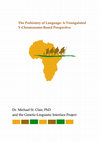
Science
By sequencing 727 ancient individuals from the Southern Arc (Anatolia and its neighbors in Southe... more By sequencing 727 ancient individuals from the Southern Arc (Anatolia and its neighbors in Southeastern Europe and West Asia) over 10,000 years, we contextualize its Chalcolithic period and Bronze Age (about 5000 to 1000 BCE), when extensive gene flow entangled it with the Eurasian steppe. Two streams of migration transmitted Caucasus and Anatolian/Levantine ancestry northward, and the Yamnaya pastoralists, formed on the steppe, then spread southward into the Balkans and across the Caucasus into Armenia, where they left numerous patrilineal descendants. Anatolia was transformed by intra–West Asian gene flow, with negligible impact of the later Yamnaya migrations. This contrasts with all other regions where Indo-European languages were spoken, suggesting that the homeland of the Indo-Anatolian language family was in West Asia, with only secondary dispersals of non-Anatolian Indo-Europeans from the steppe.
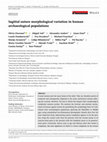
The Anatomical Record, 2021
Cranial sutures join the many bones of the skull. They are therefore points of weakness and conse... more Cranial sutures join the many bones of the skull. They are therefore points of weakness and consequently subjected to the many mechanical stresses affecting the cranium. However, the way in which this impacts their morphological complexity remains unclear. We examine the intrinsic and extrinsic mechanisms of human sagittal sutures by quantifying the morphology from 107 individuals from archaeological populations spanning the Mesolithic to Middle ages, using standardized two‐dimensional photographs. Results show that the most important factor determining sutural complexity appears to be the position along the cranial vault from the junction with the coronal suture at its anterior‐most point to the junction with the lambdoid suture at its posterior‐most point. Conversely, factors such as age and lifeways show few trends in complexity, the most significant of which is a lower complexity in the sutures of Mesolithic individuals who consumed a tougher diet. The simple technique used in t...
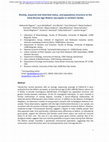
Twenty-four ancient genomes with an average sequencing coverage of 0.85±0.25 X were produced from... more Twenty-four ancient genomes with an average sequencing coverage of 0.85±0.25 X were produced from the Mokrin necropolis, an Early Bronze Age (2,100-1,800 BC) Maros culture site in Serbia, to provide unambiguous identification of biological sex, population structure, and genetic kinship between individuals. Of the 24 investigated individuals, 15 were involved in kinship relationships of varying degrees, including 3 parent-offspring relationships. All observed parent-offspring pairs were mother and son. In addition to the absence of biological daughters, we observed a number of young women and girls with no biological relatives in our sample. These observations, together with the high mitochondrial diversity in our sample, are consistent with the practice of female exogamy in the population served by Mokrin. However, moderate-to-high Y-chromosomal diversity suggests a degree of male mobility greater than that expected under strict patrilocality. Individual status differences at Mokrin...
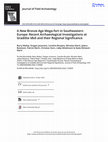
Journal of Field Archaeology, 2020
A newly discovered network of later Bronze Age fortified sites of unusually large size are discus... more A newly discovered network of later Bronze Age fortified sites of unusually large size are discussed, with a primary focus on results of excavations at the site of Gradište Iđoš. Closely associated with the rivers Mureš, Tisza, and Danube, these sites are located in the southeast of the Carpathian Basin in central Europe. On current evidence, the main period of construction and occupation took place between 1400-1100 B.C., probably constituting successor communities of the tell-centred societies of the Middle Bronze Age. Geophysical survey and excavation results from Gradište Iđoš, the largest site in this network in Serbia, are presented in this paper within their regional context. We discuss preliminary insights into the structural development of the site, alongside a correlation of new 14 C dates with relative ceramic chronological markers and the results of faunal analysis. These results provide new perspectives on settlement systems at the dawn of Urnfield cultural traditions in this region.
Antiquity, 2019
Radiocarbon dating is paramount for chronologically defining the rise of polities in the Middle B... more Radiocarbon dating is paramount for chronologically defining the rise of polities in the Middle Bronze Age Carpathian Basin. This article presents a suite of new radiocarbon dates obtained from sites associated with the Early and Middle Bronze Age Maros Group, and its Late Bronze Age successors in the Tisza-Maros region of southeast Hungary, western Romania and northern Serbia. The results indicate tight chronological synchronisation of Middle Bronze Age settlements and cemeteries in the Maros region, while confirming the accuracy of ceramic-based relative chronology for the Szőreg cemetery.
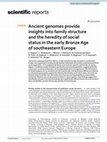
Scientific Reports, 2021
Twenty-four palaeogenomes from Mokrin, a major Early Bronze Age necropolis in southeastern Europe... more Twenty-four palaeogenomes from Mokrin, a major Early Bronze Age necropolis in southeastern Europe, were sequenced to analyse kinship between individuals and to better understand prehistoric social organization. 15 investigated individuals were involved in genetic relationships of varying degrees. The Mokrin sample resembles a genetically unstructured population, suggesting that the community’s social hierarchies were not accompanied by strict marriage barriers. We find evidence for female exogamy but no indications for strict patrilocality. Individual status differences at Mokrin, as indicated by grave goods, support the inference that females could inherit status, but could not transmit status to all their sons. We further show that sons had the possibility to acquire status during their lifetimes, but not necessarily to inherit it. Taken together, these findings suggest that Southeastern Europe in the Early Bronze Age had a significantly different family and social structure than ...

Journal of Serbian Archaeological Society, 2018
Artificial deformation of the skull is a custom of alteration of infant skull by mechanical force... more Artificial deformation of the skull is a custom of alteration of infant skull by mechanical forces. It is a very interesting phenomenon, presented in many different cultures , historical periods and continents. However, there is still no clear explanation for that practice. Most scientists, led by ethnological parallels with ancient Egypt and Peru (Inca Empire) where an elongated skull was a sign of belonging to the royal family, tend to generalize this practice and to believe that it was a status symbol and that those who had it belonged to the highest class. Nevertheless, in the case of artificially deformed skulls from the territory of Serbia, which belong to the Migration period, these comparisons are not adequate, as mentioned cultures were too far away from each other in both geographical and chronological sense. Rescue excavation in Kikinda in 2007 brought to light a new case of an individual with artificial cranial deformation. The remains belonged to a woman, 50-60 years old, with poor dental health and with various stress markers, indicators of hard physical labour. The only grave good was a spinal disk, found next to deceased's head. The tomb is dated to the Migration period, without a possibility of more precise determination. A comprehensive anthropological analysis of the individual's health status was performed. The obtained results are not in accordance with the usual common explanations of this practice and open a new debate to which more detailed and complete research can offer an answer.

The archaeological site of Gradište near Iđoš, in the municipality of Kikinda,
Serbia, is well kn... more The archaeological site of Gradište near Iđoš, in the municipality of Kikinda,
Serbia, is well known in the archaeological literature of the region. Excavated on several
occasions since 1913, the site is best known for the existence of a late Neolithic settlement where
material culture belonging to both Vinča and Tisza communities was found in the same archaeological
contexts. Furthermore, the site is known for a 250 metre diameter fortified settlement from the
Late Bronze/Early Iron Age period. А new research cycle was initiated in 2014 in order to explain
cultural processes during prehistory in this part of the Pannonian basin. The first season of the
new research campaign was focused on geophysical prospection of an area of approximately 2
hectares, geological coring and excavation of four stratigraphic trenches across the site. This
work has confirmed the existence of up to 2.5 metres of archaeological remains on the tell site
with several daub structures detected and the existence of numerous archaeological features within
the Late Bronze - Iron Age settlement.
Conference Presentations by Lidija Milasinovic
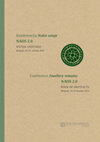
Conference Jewellery remains NAOS 2.0 BOOK OF ABSTRACTS Belgrade, 24–25 October 2019, 2019
The conference “Jewellery remains NAOS 2.0”, whose abstracts are published in this book, is organ... more The conference “Jewellery remains NAOS 2.0”, whose abstracts are published in this book, is organized by the Belgrade City Museum. The occasion is the successfully realized international cooperation on organizing the exhibition “Jewellery remains, heritage our most precious jewellery”, which marked 2018 – Year of the European Heritage in Slovenia.
Alongside the Belgrade City Museum, that participated in the event with the exhibition “The Treasure of Singidunum”, four more partner institutions from Slovenia were involved in the Project: Gorenjska Museum from Kranj, Posavje Museum from Brežice, Tolmin Museum and the Koper Regional Museum, and in the shaping of the exhibition, a large team was included, involving archaeologist curators, young artists and designers led by Verena Vidrih Perko, an expert in museology and writer.
A product was gained, that through the prism of archaeological jewellery
interprets the past in a multi-disciplinary manner. The product seeks and discovers parallels for the significance of jewellery from the past in a contemporary society and eventually, opens the museum doors to young new associates, photographers, designers and artists.
Ten archaeologists from museums and scientific institutions, from five countries in the region, were invited to the Conference; besides the archaeologists from Serbia, colleagues from Slovenia, Croatia, Bosnia and Herzegovina and Macedonia will be present, people who saw the Conference as an opportunity to present and discuss their latest findings, and five more experts also joined the event. The contributed professional papers research archaeological jewellery in a long time frame, from its appearance, and from different aspects, theoretical and practical. It starts with the Neolithic period and the analysis of jewellery representations on Neolithic figurines and ends with jewellery representations from the medieval museum collections. We evaluate the abstracts as interesting
and valuable, and, surely, this will be a Conference that will offer some other perspectives on the archaeological research.



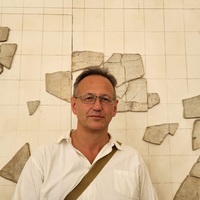






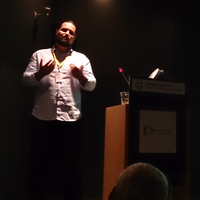
Uploads
Papers by Lidija Milasinovic
Serbia, is well known in the archaeological literature of the region. Excavated on several
occasions since 1913, the site is best known for the existence of a late Neolithic settlement where
material culture belonging to both Vinča and Tisza communities was found in the same archaeological
contexts. Furthermore, the site is known for a 250 metre diameter fortified settlement from the
Late Bronze/Early Iron Age period. А new research cycle was initiated in 2014 in order to explain
cultural processes during prehistory in this part of the Pannonian basin. The first season of the
new research campaign was focused on geophysical prospection of an area of approximately 2
hectares, geological coring and excavation of four stratigraphic trenches across the site. This
work has confirmed the existence of up to 2.5 metres of archaeological remains on the tell site
with several daub structures detected and the existence of numerous archaeological features within
the Late Bronze - Iron Age settlement.
Conference Presentations by Lidija Milasinovic
Alongside the Belgrade City Museum, that participated in the event with the exhibition “The Treasure of Singidunum”, four more partner institutions from Slovenia were involved in the Project: Gorenjska Museum from Kranj, Posavje Museum from Brežice, Tolmin Museum and the Koper Regional Museum, and in the shaping of the exhibition, a large team was included, involving archaeologist curators, young artists and designers led by Verena Vidrih Perko, an expert in museology and writer.
A product was gained, that through the prism of archaeological jewellery
interprets the past in a multi-disciplinary manner. The product seeks and discovers parallels for the significance of jewellery from the past in a contemporary society and eventually, opens the museum doors to young new associates, photographers, designers and artists.
Ten archaeologists from museums and scientific institutions, from five countries in the region, were invited to the Conference; besides the archaeologists from Serbia, colleagues from Slovenia, Croatia, Bosnia and Herzegovina and Macedonia will be present, people who saw the Conference as an opportunity to present and discuss their latest findings, and five more experts also joined the event. The contributed professional papers research archaeological jewellery in a long time frame, from its appearance, and from different aspects, theoretical and practical. It starts with the Neolithic period and the analysis of jewellery representations on Neolithic figurines and ends with jewellery representations from the medieval museum collections. We evaluate the abstracts as interesting
and valuable, and, surely, this will be a Conference that will offer some other perspectives on the archaeological research.
Serbia, is well known in the archaeological literature of the region. Excavated on several
occasions since 1913, the site is best known for the existence of a late Neolithic settlement where
material culture belonging to both Vinča and Tisza communities was found in the same archaeological
contexts. Furthermore, the site is known for a 250 metre diameter fortified settlement from the
Late Bronze/Early Iron Age period. А new research cycle was initiated in 2014 in order to explain
cultural processes during prehistory in this part of the Pannonian basin. The first season of the
new research campaign was focused on geophysical prospection of an area of approximately 2
hectares, geological coring and excavation of four stratigraphic trenches across the site. This
work has confirmed the existence of up to 2.5 metres of archaeological remains on the tell site
with several daub structures detected and the existence of numerous archaeological features within
the Late Bronze - Iron Age settlement.
Alongside the Belgrade City Museum, that participated in the event with the exhibition “The Treasure of Singidunum”, four more partner institutions from Slovenia were involved in the Project: Gorenjska Museum from Kranj, Posavje Museum from Brežice, Tolmin Museum and the Koper Regional Museum, and in the shaping of the exhibition, a large team was included, involving archaeologist curators, young artists and designers led by Verena Vidrih Perko, an expert in museology and writer.
A product was gained, that through the prism of archaeological jewellery
interprets the past in a multi-disciplinary manner. The product seeks and discovers parallels for the significance of jewellery from the past in a contemporary society and eventually, opens the museum doors to young new associates, photographers, designers and artists.
Ten archaeologists from museums and scientific institutions, from five countries in the region, were invited to the Conference; besides the archaeologists from Serbia, colleagues from Slovenia, Croatia, Bosnia and Herzegovina and Macedonia will be present, people who saw the Conference as an opportunity to present and discuss their latest findings, and five more experts also joined the event. The contributed professional papers research archaeological jewellery in a long time frame, from its appearance, and from different aspects, theoretical and practical. It starts with the Neolithic period and the analysis of jewellery representations on Neolithic figurines and ends with jewellery representations from the medieval museum collections. We evaluate the abstracts as interesting
and valuable, and, surely, this will be a Conference that will offer some other perspectives on the archaeological research.